染色作家・浄土紀久子の両面 手描き染めシルクスカーフ┃kikuko-online
It is an interview to paradise Kikuko by the Q&A form. It talks about sticking to as the dye writer and the trait etc. of the work.
It is an interview to paradise Kikuko by the Q&A form. It talks about sticking to as the dye writer and the trait etc. of the work.
All are created with my own hand, and I think that the travel of own search makes up the work of all my works.
I joined Issei Miyake’s studio when I was a student of university, making rough ideas of colors and patterns of textile and knit clothing. Then I started to work with other expert of apparel field, and drew sketches of many designers’ brand. Thus my position is mixture of traditional dye craftsman and textile designer for brand apparels. I am sure that experiences of designers’ brands such as with Isssei Miyake would be a big help on my various selection of material.
I always watch the material cloth carefully before starting my work step. I feel it by hand and try to listen to what the cloth talking to me. As I use variety of cloths, I have to expect characteristics of each of them and then select the best techniques and method of expression for the cloth. Even if the cloth says “100% silk”, color brightness, shimmering or blotting differs each. I should say this as “calling voice of the cloth”. Images may be imported from cloth itself.
I put on colors on cloth like water painting, but a lot of time is required after painting, which is different from paint on paper or canvas. In hand paint dying, I have to steam the painted cloth once to fix the colors, and then they have to be washed with water. One day for water wash the material before painting, a couple of days for painting, one day for steaming and another one day for last water wash. Quite a long time, isn’t it?
I use so many kinds of cloths, such as silk, wool, hemp, cotton and chemical fibers. I paint on “both sides of one sheet of cloth” that no one ever tried, based on techniques of regular Yuzen Kimono, still having a fashion style of the trend. I have crated so many artworks of various style enough to make a “Scarf & Stole Museum”.
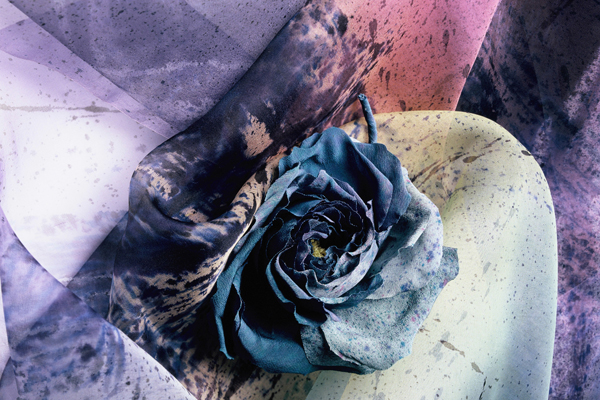
Personality of the artist is appeared in the artwork, and it shows the artist itself! Always polish myself, be honest and never get frightened to challenge! Artist should enjoy creating his/her art-works, otherwise the joy of creation doesn’t be brought to customers and cannot be received as charming!
I wake up with sunrise. Natural light is most important to observe true colors. Very healthy and natural life, isn’t it? Painting pictures on a large cloth spread horizontally in air is a very hard work physically. Steaming and water wash are also heavy work. I train myself at a sport club at night. Content of my work differs day after day. “Paining” is not my total work. I have to spend whole day for steaming, and another day I may continue to water wash only. It may be resembles to the life before Industrial Revolution!
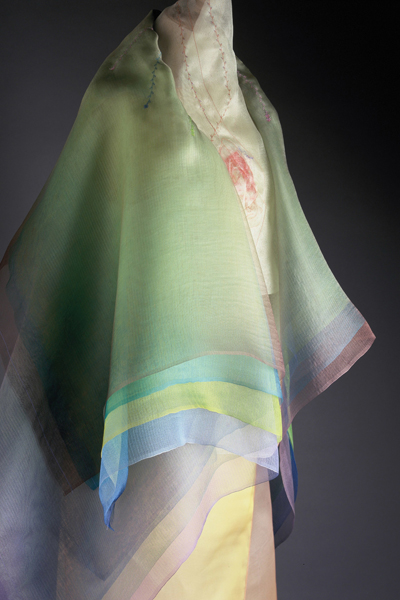
My aim is to create artworks of high quality and wearable for life time. You can use my art-wears in daily occasions, and they are strong enough to endure water washing at home and with high sense of art. I want to make art-wears that gently heal and touch the heart of customer with various color harmonies and enjoyable to watch. My customers often send me comment “kikuko’s art-wears really make me happy, not only by wear also by just watching it!”
I put different colors on both sides of one sheet of cloth. This method is created and developed by myself. Yes, it is confidential! I’ve thought about patent application, but there may be some risk of infringement where I cannot find its proof by describing it into details. Many apparel designs are copied by overseas nowadays!
Major point is material cloth itself is my original, not only “paint on both sides” or “unique color or picture”. I use deformed shape as well as square, combination of different material and some are bulgy by stitched relief. I wish you could notice such points.

No, I use acid dyestuff, for they are suitable for mixing colors freely and finish on bright colors. Botanical dyestuff does not cover so many kinds of colors and not suitable to paint pictures. Botanical dyestuff is easier to discolor also.
When I was a high school student, everyone thought I might go up to a gymnastic school, because I had the best time record of swimming in the district. I wondered if it could be possible being an active sport player throughout my life. I didn’t decide my future clearly when I was 17 years old, still I thought I could fined something which I can continue to challenge for my life at Art University. I might found unrestricted feeling there.
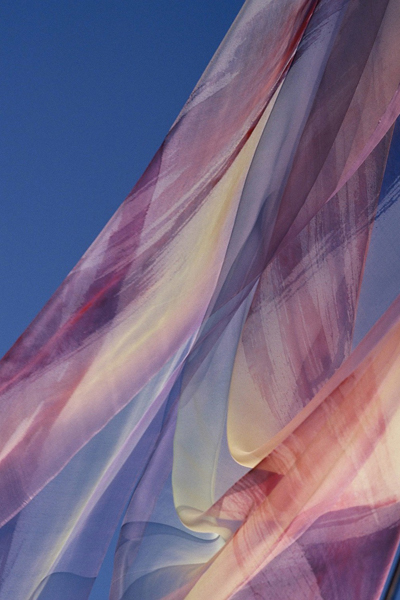
I wanted to make something which we can use in our daily life, not like fine arts hung on wall in decorated frames. As I loved pretty dresses and grew up with many rolls of textile, I thought I could get a connection with apparel field quite. Perhaps I selected “fabric and color” among huge numbers of life work unconsciously when I was 17.
Yes, Issei Miyake comes top of the list! He realized “harmonizing art, clothing and fabric” and I learned all fundamentals of fabric craft-work. I can list up Mr. Don Konishi, a creator of a unique art-knitting, a handcraft artist of beautiful and sensitive Tsumugi weaving, learned colors, shapes and structures as paintings from Claude Monet, a glass artist on his dreamy fusion of colors. Of course my closest partner of my life, Takuro Iwamoto is essential to me!
I strongly wished to introduce my artworks to as many guests as possible, who cannot come and see my own exhibitions mostly held in Tokyo. Once you see and touch my artworks by yourself, you are sure to confirm its smooth touch, quality of material and you may find how to wear it for your best. I’d like to show my idea: “A new dying works are born based on traditional Japanese art-draft” to wherever you live. This would be a way to leave “traditional dye-craft originated in Japan” to worldwide in future.
I truly worried about this point. But there is a merit as well. You can see my works wide spread on both sides next to each other on monitor screens, more details can be cleared compared with watching them on actual galleries. Some galleries in department stores such as Mitsukoshi, you cannot watch my works in spread form due to lack of wall side areas. By “kikuko-net”, you can enjoy watching them at any time you like taking as long time as you wish.

Well, it is difficult to choose my best selling item. All of my works are made by me and no one item is same to the others in their sizes, colors and materials. This point is completely different from those made by mass-production.
I am always invited to opening reception parties of opening program of Tokyo National Art Museum and its Art Craft Museum locating near Imperial Palace, and I attend them as my schedules permit, for some paintings of my husband are stored in the National Museum. Every time I can enjoy new programs and enjoy meeting many artists and gallery owners there.
Well, I recommend Metropolitan Art Museum in NY, and Louver Art Museum. They have lots of paintings sculptures and handcrafts from all around the world on any age. You can peep into the history of life style by looking over mountainous exhibitions there. I also love art museums in midtown of Tokyo because of easy access.
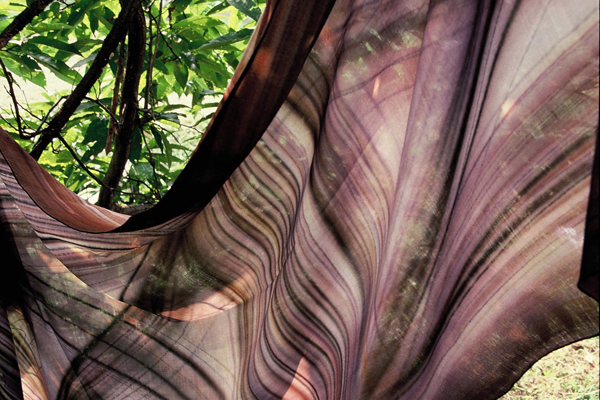
Most of my customers are those who loves fashionable clothing, have independent value sense, and especially who have free feeling in their mind. Most of my customers can appreciate true beauty of fine arts and art-crafts, and seem to collect long-life fashion items. They love unique shape and colors which you cannot fined in other markets. I respect those who are over 80 years old, collecting my artworks for more than 20 years and still come to my exhibition with outfit of good sense. I really appreciate my fans very much, for they have grown me up to what I am now.
I was born in Tokyo. My uncle was a Kabuki actor and he lived near Kabuki-Theatre and rehearsal room. I have seen many Kabuki stages and kimono costumes. As my mother was a tailor of custom made clothing, I grew up with a lot of fabrics. I loved sewing my dolls’ dresses by myself!
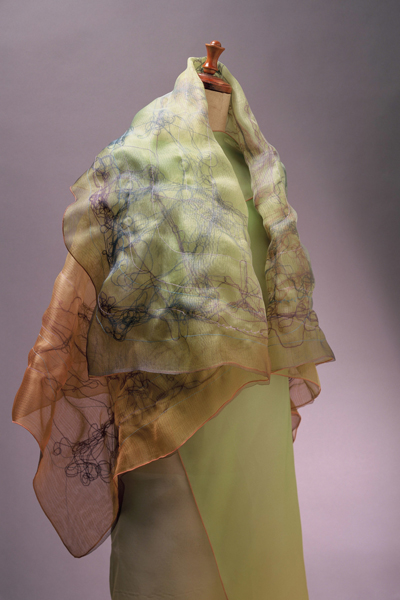
Well, I think so, but wasn’t so easy to get myself right now. I have challenged many things. I entered Tama Art University, made a big presentation to Issei Miyake showing a hundred of my original works, and etc. I have worked on many designers’ brands, worked as a stylist and as an illustrator for magazines and picture books. I also worked at a modern art gallery, too.
Of course not! They told me that it was quite hard to make living as an artist, like many of the rest might say so. But I could persuade them by telling “I want to keep challenging on my way because a life is once for everyone!”
When I started dying in university I didn’t have clear image of my work. Now I feel it must be a quite natural to use fabrics as a method of my expression recalling over my childhood. I think myself very lucky finding my own means of expression and continuing it for more than 30 years.
Well, work with brand makers were making rough sketches, using only brain and no physical action required. So I wanted to do something more natural to me. The true joy of creation, I think, is to accomplish all procedures from zero to completed form all by myself. I decided to create what nobody else had tried, such like “a hand-craft with fashionable sense that can be completed all by myself”! The largest key to my determination was a push from a fashion analyst: “If you really wish to do, you can do it. Just try your own way!”
Oh, you mention “soaking method”, a popular style of dying. I have created my own original method based on “Yuzen-zome” of kimono. Please imagine that you spread a long cloth flat in air, and draw a water paint picture on it. Then steam the picture to fix the colors on the cloth.
I dissolve powder dyestuffs for kimono with chemicals and warm water, like color inks, to paint on cloth. Color must be fixed by steaming after painted. But I like this acid dyestuff best, because I can get brightest colors and easiest to mix many colors.
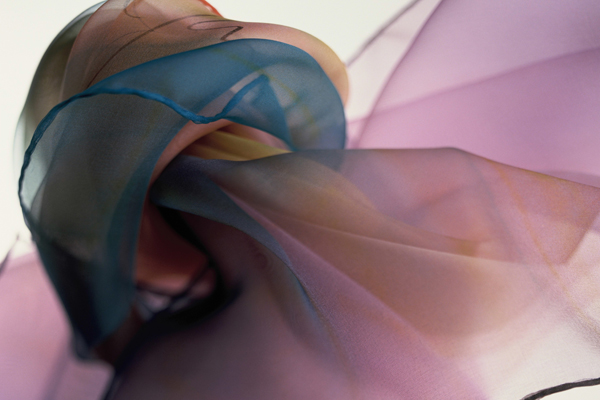
Mrs. Fukuda (ex-Prime Minister’s wife), Mrs. Takamura (ex-Minister of Foreign Affairs’s wife), Mr. and Mrs. Hiroshi Yagyu (an actor), Ms. Mie Hamada (an actress), Mrs. Yasuji Suzuki (a picture book writer), Ms. Yoko Uozumi (a novelist), Ms. Chizuko Kamino (a leader of Japanese feminism), Ms. Kumiko Kato (a cooking instructor), Mr. Yuzan Nakano (a master of Kado), Ms. Miru Ichiyanagi (an actress), and etc. I am planning to present my artworks to who I think to fit most.
Most distinctive difference between such merchandise in market and my artworks is: they can be directly put colored on cloth which do not need steaming and water wash. By such method, delicate and complicated fusion of colors, graduation, blotting or running of colors which you see in my works can never be appeared on mass-sale markets.
I don’t use any cheap materials from Asian countries. I only use those from Italy, France and Japan. I prefer delicate and luxurious material to coarse and rough ones. Those high quality materials can endure water washings also.
I intend to make art-dresses like kimono, which are not influenced by day-to-day trend. Size should be free and shows various expressions by physical shape of customers. I am now looking for a possibility on a sheet of cloth to change it to wearable art, not cutting it into pieces. My concept on my art is “to wear painting”. Isn’t be fancy if you have a dress which you can wear in many ways, like both sides can be outside and wear in up side down?
I wish to take a time to look inside of “a garner closet of art costumes” in Metropolitan Museum. They store the clothing of the highest quality in largest quantities in the world.
Traveling is my most favorite luxury! I always desire new experiences and stimulations which is necessary for an artist. I’d like to travel all around the world, especially where I have never bee before!

Colors of dreamy sky in twilight, natural sceneries and fine arts and art-crafts remained though world histories give me inspirations for my work. I’m also very curious on new trend so I spread my antenna on ads of fashion and media very carefully. I think I’m influenced by all stimulations around me. Traveling gives me lots of stimulations in my mind, too.
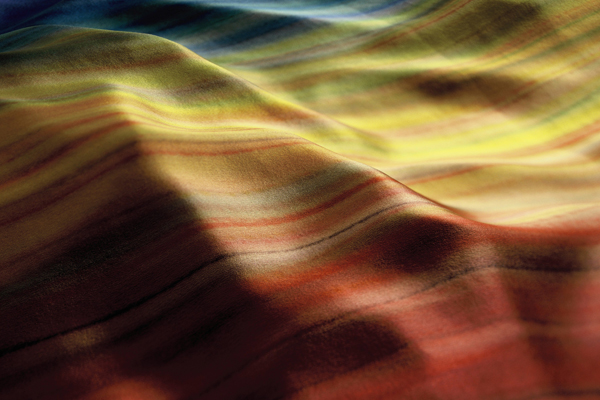
I have no OFF day, for I am working on “what I like to do most”. Painting on fabric with dyestuff is not same as oil painting on canvas. I cannot over-paint colors until the basic color is dried. I cannot finish one work at one time because steaming and water washing is also necessary. So every day I am busy with some kind of work unless I can go travel.
A wide space with at least 15m length for rolled silk for kimono. I have to spread a roll of silk flat to 15m length is minimum necessity. Floor must be concrete-made for water can flow during fading colors. Also my working room is surrounded by high ceiling and white walls to obtain enough natural sunlight. Besides this factory, another room with wooden floor, white walls and large windows is required for procedures before and after painting. I think not so many people can obtain such wide space except living in local areas.
There is no number limitation for painting pictures, are they? My work is same as this. Many items you can see in markets have mass-printed patterns. The more colors you need, more patterns are necessary. To avoid high cost the number of colors is restricted. As I paint by my hand, I’d like to use this merit as much as possible. I often use gradations and blotting, for they are expressions that can hardly made by mass-printing. I also think for Japanese, more delicate, sensitive or deeply profound coloring like kimonos matches better than those with clear and distinctive patterns. By using many colors, I think it makes easier to choose your outfit to go well with my artwork.
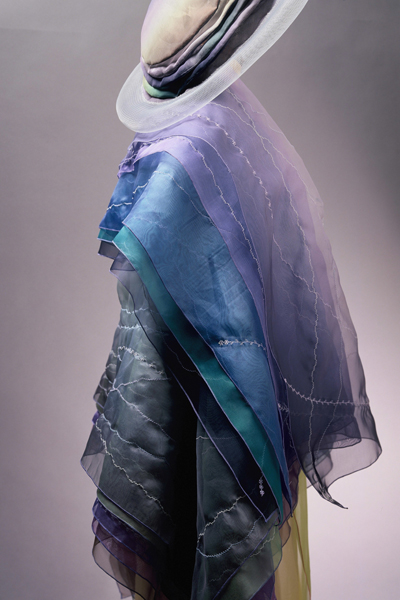
Yes, two grownup daughters. They are my source of new sense and knowledge of young people and they are very severe critics. The photo of my second daughter is used on this site. This photo is delivered to all over the world as sales promotion of NICON.
Yes, I am married with a talented paint artist. He really is my best partner! He exists most close to me and sometimes we collaborate with each other on our art work.
I am very much affected by his paintings and sense of art. “We cannot live without each other” to live as a couple. Off course, we support each other, too!
I’d like to collaborate with those who can make my art-cloth to a cubic dress. As for my 1st trial, I am going to collaborate with Ms. Michiko Kato, who is a friend of mine, with a brand name “Gahoo”. This brand name would be written by Mr. So-un Takeda, a famous modern calligrapher in Japan.

I would like to make stage costumes for the artists whom I think my art-dresses matches well. I have devoted in making artworks since now, I’d like to present my dresses to art fields positively.
Yes, I have no follower. I have no sub-contract either including Asian countries. All of my works are finished by me alone, devoting all my energy from beginning to the finish. I think such works are really desired now, which one person is totally responsible for the item.
I’d like to show my works in more far areas and various ages of customers, wishing they can feel my works by hands, because so far I have held my own exhibitions in department stores like Mitsukoshi and Takashimaya, Tokyo, as well as at some galleries of Shonan, Kamakura and Karuizawa. This is a reason why I started this net-shop. I hope you would compare my art-wear with those sold in market. I am sure you’ll fined difference of materials, delicate and depth of colors on my works. Most customers who have bought my art-wear once come back to me as repeaters!
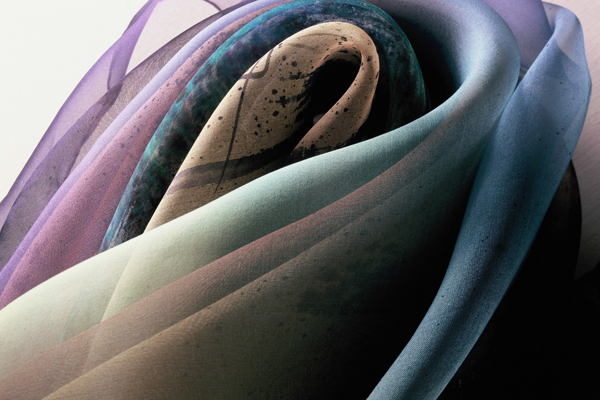
Please come and join us at galleries for my own exhibition! I do hope you would watch closely, feel by hands, and wear it on yourself. It must be a joyful moment for both of us!
I am going to hold my own exhibition at a gallery “Amuse” in the main store of Mitsukoshi, Nihonbashi, from Feb. 17 to 23 on 2009. I’d be very glad to see you there who get interested in my artworks by this “kikuko net-shop” and wish you to touch them by yourself. Of course I’ll be there every day.